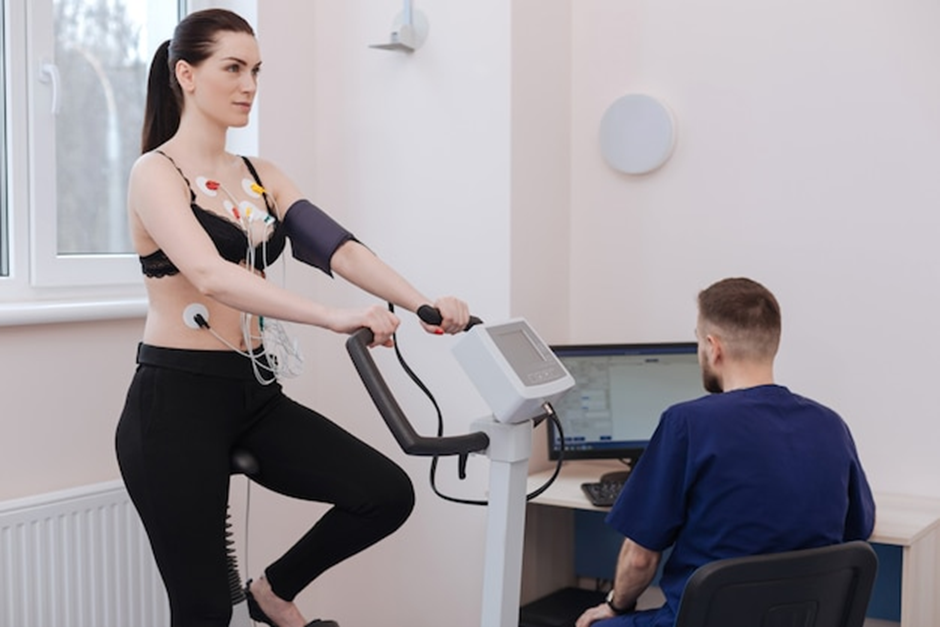Our hearts work tirelessly every day. Keeping them in check is crucial. One way to help ensure good heart health is the TMT, or Treadmill Test. This test provides insights into how well your heart functions during physical activity. Learning about it empowers you to make informed decisions about your health.
What Exactly is a Treadmill Test?
A TMT, or Treadmill Test, is a simple procedure. It checks how your heart performs under stress. Also known as an Exercise Stress Test or Exercise Electrocardiogram, this test has been around for decades. It helps doctors spot signs of heart disease. In India, it has become a valuable tool in heart health evaluations.
During the TMT, you walk on a treadmill. The speed and incline increase gradually. It challenges your heart as though you’re going for a brisk walk or a light jog. While doing so, doctors monitor your heart’s activity through an ECG.
How Do Treadmill Tests Work?
The TMT process is straightforward. Here’s what usually happens:
- Preparation: You change into comfortable clothes and shoes. Sensors are attached to your chest to monitor heart activity.
- Warm-Up: The treadmill starts at a slow pace.
- Exercise Phase: Gradually, the pace and incline increase. You continue until you reach a safe heart rate or feel any discomfort.
- Monitoring: Throughout, an ECG and blood pressure monitor keep track of your heart.
- Conclusion: After the exercise, you cool down.
A typical TMT takes about 10-15 minutes. This brief period offers valuable insights into your heart’s health.
Reasons Your Doctor Might Recommend a Treadmill Test
Doctors suggest a TMT for several reasons:
- Assessing Heart Health: It helps check for coronary artery disease. This condition affects blood vessels supplying the heart.
- Detecting Irregular Heartbeats: The test observes your heart rhythm, spotting any arrhythmias.
- Evaluating Exercise Capacity: It’s a way to understand how your heart copes with physical activity.
- Blood Pressure Response: How your blood pressure changes during stress is crucial.
- Pre-Surgery Evaluation: Before some surgeries, doctors use TMT to ensure heart stability.
- Monitoring Existing Conditions: If you have heart issues, it helps track your heart’s condition over time.
This array of benefits shows why your doctor might see a TMT as a vital step.
Getting Ready for Your Treadmill Test
Preparation for a TMT is easy:
- Clothing: Wear loose, comfortable clothes and sturdy shoes.
- Food and Drink: A light meal a few hours before is fine, but avoid heavy foods. Stay hydrated, but avoid too much caffeine.
- Medications: Check with your doctor. Some medicines may need adjustment on test day.
Being prepared helps reduce anxiety and ensures the test goes smoothly. Knowing what to wear and eat simplifies the process.
Your Experience During the Treadmill Test
Here’s what to expect during a TMT:
- Initial Checks: Before you start, the team takes your blood pressure and other vital signs.
- Exercise: You walk on the treadmill, following easy steps as the pace and incline increase.
- Monitoring: Throughout, the medical staff closely watches your heart and overall wellbeing for safety.
- Completion: When the test ends, the treadmill slows down and you cool down gradually.
This structured process ensures your safety and comfort, making it a manageable experience.
Post-Treadmill Test: What Happens Next?
After the TMT, you can usually return to your daily routine. Sometimes, results are available immediately, but often, they take a day or two. Doctors provide insights into your heart’s health, explaining results in simple language.
If needed, they suggest next steps based on what the TMT reveals. Knowing what happens post-test helps keep you informed and reassured about your health.
Benefits and Limitations
The TMT offers a safe, non-invasive way to understand your heart’s health. However, there are factors to consider:
Benefits: – Comprehensive Insight: It gives a clear picture of your heart’s function under stress. – Non-Invasive: No cuts or needles are involved; just monitoring while you walk.
Limitations: – Not for Everyone: Those with certain conditions, like severe joint problems, may not be suitable candidates. – Risk of Misinterpretation: Sometimes additional tests are needed to confirm TMT results.
For some, alternative tests like a Chemical or Imaging Stress Test might be better suited. Knowing these factors helps you discuss options with your doctor.
Concluding Thoughts on the Treadmill Test
Incorporating a TMT into your health routine can be a key strategy in maintaining heart health. Discuss it with your healthcare provider to see if it’s right for you. Understanding the TMT empowers you in your health journey, offering both knowledge and peace of mind.
In conclusion, exploring the Treadmill Test opens doors to better heart health. Whether you’re understanding your current condition or planning preventive measures, the TMT can be a vital ally in your healthcare journey.



